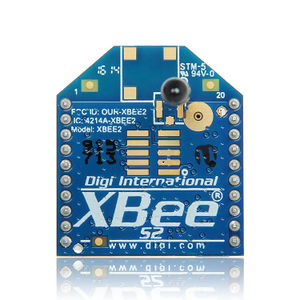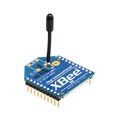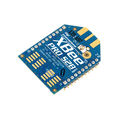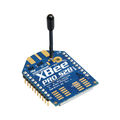Difference between revisions of "XBee"
(→Series of XBees) |
(→Series of XBees) |
||
| Line 46: | Line 46: | ||
=Series of XBees= | =Series of XBees= | ||
| − | *XBee Series 1 (also called XBee 802.15.4) - These are the easiest to work with, they don’t need to be configured, although they can benefit from it. Because they are easy to work with we recommend these especially if you are just starting out. For point to point communication these modules work as well as the Series 2 but without all the work. A Series 1 module won’t say Series 1 on it, but it also won’t say Series 2. If it doesn’t say then your module is a Series 1. Series 1 and Series 2/2.5/ZB hardware are NOT compatible. [https://www.sparkfun.com/datasheets/Wireless/Zigbee/XBee-Datasheet.pdf Datasheet] | + | *XBee Series 1 (also called XBee 802.15.4) - These are the easiest to work with, they don’t need to be configured, although they can benefit from it. Because they are easy to work with we recommend these especially if you are just starting out. For point to point communication these modules work as well as the Series 2 but without all the work. A Series 1 module won’t say Series 1 on it, but it also won’t say Series 2. If it doesn’t say then your module is a Series 1. Series 1 and Series 2/2.5/ZB hardware are NOT compatible. [[File:XBee -s1-Manual .pdf]][https://www.sparkfun.com/datasheets/Wireless/Zigbee/XBee-Datasheet.pdf Datasheet] |
*XBee Znet 2.5 (Formerly Series 2) Retired - These are the fun ones. Series 2 modules must be configured before they can be used. They can run in a transparent mode or work with API commands, but this all depends on what firmware you configure these with. These also can run in a mesh network making them highly configurable and awesome modules. It also makes them harder to use modules. These modules are in no way compatible with the Series 1 modules. These modules are no longer sold but are being replaced with the mostly compatible ZB modules. [https://www.sparkfun.com/datasheets/Wireless/Zigbee/XBee-2.5-Manual.pdf Datasheet] | *XBee Znet 2.5 (Formerly Series 2) Retired - These are the fun ones. Series 2 modules must be configured before they can be used. They can run in a transparent mode or work with API commands, but this all depends on what firmware you configure these with. These also can run in a mesh network making them highly configurable and awesome modules. It also makes them harder to use modules. These modules are in no way compatible with the Series 1 modules. These modules are no longer sold but are being replaced with the mostly compatible ZB modules. [https://www.sparkfun.com/datasheets/Wireless/Zigbee/XBee-2.5-Manual.pdf Datasheet] | ||
Revision as of 02:48, 4 November 2014
Contents
Introduction
XBee is the brand name from Digi International for a family of form factor compatible radio modules. The first XBee radios were introduced under the MaxStream brand in 2005 and were based on the 802.15.4-2003 standard designed for point-to-point and star communications at over-the-air baud rates of 250 kbit/s. Two models were initially introduced—a lower cost 1 mW XBee and the higher power 100 mW XBee-PRO. Since the initial introduction, a number of new XBee radios have been introduced and all XBees are now marketed and sold under the Digi brand.
The XBee radios can all be used with the minimum number of connections – power (3.3 V), ground, data in and data out (UART), with other recommended lines being Reset and Sleep. Additionally, most XBee families have some other flow control, I/O, A/D and indicator lines built in. A version of the XBees called the programmable XBee has an additional onboard processor for user’s code. The programmable XBee and a new surface mount (SMT) version of the XBee radios were both introduced in 2010.
As of February 2013, the XBee radio family consists of
XBee 802.15.4 – The initial point-to-point topology or star topology module running the IEEE 802.15.4 protocol
XBee-PRO 802.15.4 – A higher power, longer range version of the XBee 802.15.4
XBee DigiMesh 2.4 – A 2.4 GHz XBee module which uses DigiMesh, a sleeping mesh networking protocol developed by Digi International
XBee-PRO DigiMesh 2.4 – A higher power, longer range version of the XBee DigiMesh 2.4
XBee ZB – An XBee module that incorporates the ZigBee PRO mesh networking protocol
XBee-PRO ZB – A higher power, longer range version of the XBee ZB
XBee ZB SMT – A surface mount XBee running the ZigBee protocol
XBee-PRO ZB SMT – A higher power, longer range version of the XBee ZB SMT
XBee SE – An XBee ZB module that incorporates the security cluster for the ZigBee Smart Energy public profile
XBee-PRO SE – A higher power, longer range version of the XBee SE
XBee-PRO 900HP - A 900 MHz XBee-PRO module with up to 28 mile range with high-gain antenna, which supports DigiMesh networking protocol
XBee-PRO 900 (Legacy) – A 900 MHz proprietary point-to-point and star topology module, not recommended for new design
XBee-PRO XSC (S3B) – A 900 MHz module compatible over the air with the Digi 9XStream radios
XBee-PRO DigiMesh 900 (Legacy) – A 900 MHz module which uses DigiMesh, not recommended for new design (see XBee-PRO 900HP for new designs)
XBee-PRO 868 – An 868 MHz 500 mW long-range module which supports proprietary point-to-point and star, for use in Europe
XBee 865/868LP - An 868 MHz XBee module which uses DigiMesh, available in Surface Mount form-factor (also configurable to 865 MHz for use in India)
Here is an official comparasion of all the XBEE modules.XBee Features comparasion
Series of XBees
- XBee Series 1 (also called XBee 802.15.4) - These are the easiest to work with, they don’t need to be configured, although they can benefit from it. Because they are easy to work with we recommend these especially if you are just starting out. For point to point communication these modules work as well as the Series 2 but without all the work. A Series 1 module won’t say Series 1 on it, but it also won’t say Series 2. If it doesn’t say then your module is a Series 1. Series 1 and Series 2/2.5/ZB hardware are NOT compatible. File:XBee -s1-Manual .pdfDatasheet
- XBee Znet 2.5 (Formerly Series 2) Retired - These are the fun ones. Series 2 modules must be configured before they can be used. They can run in a transparent mode or work with API commands, but this all depends on what firmware you configure these with. These also can run in a mesh network making them highly configurable and awesome modules. It also makes them harder to use modules. These modules are in no way compatible with the Series 1 modules. These modules are no longer sold but are being replaced with the mostly compatible ZB modules. Datasheet
- ZB (the current Series2ish module) - Basically the Znet2.5 hardware with new firmware. Meaning they can also run in a transparent mode or work with API commands. They can also run in a mesh network making them highly configurable and awesome modules. You can grab the new firmware and upgrade them yourself. The firmware between the two is not compatible (but is easily interchangeable) so you will have to pick which firmware you want to use on your network and stick with it. Download the conversion kit here. These are often call Series 2 modules, so if you hear someone talking about Series 2, they might be talking about these. It may not be the correct term, but it does distinguish these from the Series 1 modules which is usually all people want to know. These modules will not work in any way shape or form with the Series 1 . Datasheet
- 2B(the even more current Series2ish module) - These new modules improve on the hardware of the Series 2 modules improving things like power usage. They run the ZB firmware but because the hardware has been changed they can no longer run the Znet2.5 firmware. So if you are looking to add this to an existing 2.5Znet network beware. Currently some of our boards are 2B and others are ZB
- 900MHz - Technically not a series but it is a family just like the others. The 900s can run 2 different types of firmware, the DigiMesh firmware and the Point to Multipoint firmware. Digi actually sells both modules, the hardware is the same just with different firmware. Sparkfun only sells the point to multipoint version, but hey, you can change the firmware yourself. These modules should be more or less plug and play but of course can benefit from all the cool features you can configure.User Manual: XBee-PRO 900HP S3B Modules
Government Agency Certifications
- XSC - Basically these are 900 modules that sacrifice data rate for range. The regular 900 modules have a data rate of 156KBps (the others are all around 250Kbps) but the XSC module is only about 10Kbps. On the other hand if you attach a high gain antenna you can get a range of about 15 miles and 6 miles with a regular antenna. These modules do not require configuration out of the box and have some other differences including a different command set so make sure you check out the datasheet.
- XSC S3B - This is an upgraded version of the XSC modules which is less power-hungry than the previous generation despite having a higher selectable transmitting power of 250mW. This higher Tx power allows for line-of-sight range up to 28 miles with the right antenna. The S3B modules also feature higher-throughput than the previous generation XSC modules.
Form-factors, antennas, and data modes
XBee Modules are available in two form-factors; Through-Hole and Surface Mount. All XBees (with the exception of the XBee 868LP) are available in the popular 20-pin Through-Hole form-factor. Certain XBee modules are also available in a 37-pad Surface Mount design, which is popular for higher volume applications due to the reduced manufacturing costs of SMT technology.
The XBees can operate either in a transparent data mode or in a packet-based application programming interface (API) mode.In the transparent mode, data coming into the Data IN (DIN) pin is directly transmitted over-the-air to the intended receiving radios without any modification. Incoming packets can either be directly addressed to one target (point-to-point) or broadcast to multiple targets (star). This mode is primarily used in instances where an existing protocol cannot tolerate changes to the data format. AT commands are used to control the radio’s settings. In API mode the data is wrapped in a packet structure that allows for addressing, parameter setting and packet delivery feedback, including remote sensing and control of digital I/O and analog input pins.
Antennas
XBee Modules typically come with several antenna options, includingChip ,Wire, U.FL, RPSMA and PCB Embedded.
- Chip Antenna – Basically a small chip that acts as an antenna. Quick, easy, cheap, not in the way. These are being phased out in favor of trace antennas, which are essentially the same but printed directly to the circuit board.
- Wire Antenna – Well its a small wire sticking up, a little more of what you think of when you think of antenna.
- u.FL Antenna – A tiny connector to connect your own antenna, this is great if your object is in a box and you want your antenna outside the box.
- RPSMA Antenna – A bigger connector to connect your own antenna, once again great if your object is in a box and you want your antenna outside the box.
- Trace Antenna – Also called a PCB antenna, these are formed directly on the module with conductive traces. They perform about the same as wire antennas.
Regular, Pro and other things
Regular vs Pro - There are a few difference between the regular XBees and the XBee Pros. The Pros are a bit longer, use more power and cost more money. That’s pretty much it. The greater power means longer range (1 mile instead of 300ft) so if you need the range or like to spend more money, then use the Pros, otherwise stick with the regular models. You can mix and match these on the same network.
900 vs 2.4 - Most of the Xbee modules operate at 2.4GHz, but there are a few that operate at 900MHz. Basically 900MHz can go a lot farther with a high gain antenna (up to 15miles for the Pro modules and a high gain antenna). Also the lower the frequency the greater penetration the signal has. 900MHz is also not allowed in many countries (although there are 868MHz versions available from Digi that are allowed in many other countries). You can NOT mix and match these on the same network.
IEEE802.15.4 VS ZigBee VS DigiMesh
IEEE 802.15.4
IEEE 802.15.4 is a standard which specifies the physical layer and media access control for low-rate wireless personal area networks (LR-WPANs). It is maintained by the IEEE 802.15 working group, which has defined it in 2003. It is the basis for the ZigBee, ISA100.11a, WirelessHART, and MiWi specifications, each of which further extends the standard by developing the upper layers which are not defined in IEEE 802.15.4. Alternatively, it can be used with 6LoWPAN and standard Internet protocols to build a wireless embedded Internet.
IEEE standard 802.15.4 intends to offer the fundamental lower network layers of a type of wireless personal area network (WPAN) which focuses on low-cost, low-speed ubiquitous communication between devices. It can be contrasted with other approaches, such as Wi-Fi, which offer more bandwidth and require more power. The emphasis is on very low cost communication of nearby devices with little to no underlying infrastructure, intending to exploit this to lower power consumption even more.
The basic framework conceives a 10-meter communications range with a transfer rate of 250 kbit/s. Tradeoffs are possible to favor more radically embedded devices with even lower power requirements, through the definition of not one, but several physical layers. Lower transfer rates of 20 and 40 kbit/s were initially defined, with the 100 kbit/s rate being added in the current revision.
Even lower rates can be considered with the resulting effect on power consumption. As already mentioned, the main identifying feature of IEEE 802.15.4 among WPANs is the importance of achieving extremely low manufacturing and operation costs and technological simplicity, without sacrificing flexibility or generality.
Important features include real-time suitability by reservation of guaranteed time slots, collision avoidance through CSMA/CA and integrated support for secure communications. Devices also include power management functions such as link quality and energy detection.
IEEE 802.15.4-conformant devices may use one of three possible frequency bands for operation (868/915/2450 MHz).
Hardware that is with the IEEE 802.15.4 protocol are Series 1-802.15.4.
To know more about IEEE 802.15.4,please check here for detailes
ZigBee
ZigBee is a specification for a suite of high-level communication protocols used to create personal area networks built from small, low-power digital radios. ZigBee is based on an IEEE 802.15 standard. Though its low power consumption limits transmission distances to 10–100 meters line-of-sight, depending on power output and environmental characteristics,ZigBee devices can transmit data over long distances by passing data through a mesh network of intermediate devices to reach more distant ones. ZigBee is typically used in low data rate applications that require long battery life and secure networking (ZigBee networks are secured by 128 bit symmetric encryption keys.) ZigBee has a defined rate of 250 kbit/s, best suited for intermittent data transmissions from a sensor or input device. Applications include wireless light switches, electrical meters with in-home-displays, traffic management systems, and other consumer and industrial equipment that requires short-range low-rate wireless data transfer. The technology defined by the ZigBee specification is intended to be simpler and less expensive than other wireless personal area networks (WPANs), such as Bluetooth or Wi-Fi.
Hardware that is with the ZigBee protocol are S2 series. Check here for further imformation.
DigiMesh
DigiMesh is a proprietary peer-to-peer networking topology for use in wireless end-point connectivity solutions. The nature of its peer-to-peer architecture allows DigiMesh to be both easy to use and equipped with advanced networking features, including support for sleeping routers and dense mesh networks. Overhead associated with the protocol and data payload is optimized for network performance and addressing is made simple so you spend less time defining your network, and more time on your application.
As a portable protocol, DigiMesh can be deployed in a number of wireless products servicing a broad array of applications needs, including multiple frequencies and hardware platforms. There are plans for several embedded RF module offerings, as well as ready-to-deploy non-embedded solutions including adapters, network extenders and technology gateways.
Hardware that is with the DigiMesh protocol are S3B series and Series 1-DigiMesh.
You can refer here to get more imformation.
Gallary of XBee
- S2.png
series 2




